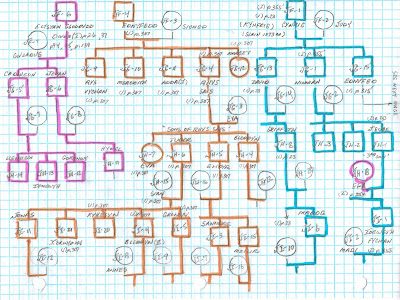Subordination to a higher authority can bring about all kinds of changes to the home front. For my ancestors, following the Statute of Rhuddlan 1284, changes were introduced in what became the new areas called Flint [Tegeingl and Maelor Saesneg], Denbigh [Ros and Rhufoniog], Rhuthun [Cantref of Dyffryn Clawyd], and Bromfield & Yale [Maelor Gymraeg]. A new governmental framework was established involving the institution of "English" criminal law to what was the families' common law. The focus here are the Maelors since Tudor Trevor (JC-1) was recognized as the founder of "The tribe of the Marches" where the Maelors played a central role.
Let's see now. New fellows named "Sheriffs" were appointed to administer each of these new named areas. They were to collect rents and new taxes owed to the new "Lord Paramount" which was conceived as the "The Crown". Sheriffs were to supervise local officials and, hold a court once a month [Juries introduced]. The IRS [Exchequer at Westminster] held the purse strings but, local jurisdiction was considered legitimate authority. A solemn treaty it was announced. From "Common Law" to "State Law" was the main change of concept thus, providing an order and tranquility to that wild and free way of living among all the family. (Hywel Dda would certainly have something to say about all these changes.)
"Movables" (inheritances) was to remain under common law and, land disputes could be solved by the local folks. Since the family moved to Llwyn-Onn, Iorwerth Fychan (JI-1) [see post of 28 August 2023], until Llewelyn (JL-1), who was named after Llywelyn (II) [who died 11 December 1282], the family had already made a number of adjustments to the mindset. For example, there were new ways of survival (post 11 Oct 2023 "Food & Fleece") and self-sufficiency (post 20 Nov 2023). A new network of connectors were established as discussed in post of 23 Sept 2023 ("Highroads"). The family then faced a series of ground shaking events and a series of tidal waves [see post 1 Dec 2023 ("Sea of Troubles") and, 6 Jan 2024 ("Shifting Sands")]! Then Howel (JM-1) had to submit to a new authority with a whole bunch of new horizons to face.
Hum...the "Hundred Years War" 1337-1453, the battle of Calais 1346, the "Black Death" 1350, and the battle of Poitiers 1356, were all about to hit the fan under this new prerogative of "The Crown"... new rules and new Rulers, what can one say.
For review: family tree from Iorwerth Fychan (JI-1) to Howel (JM-1). All marked with blue color.







